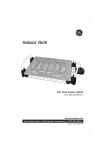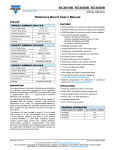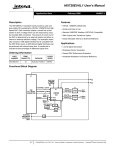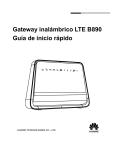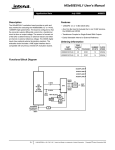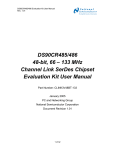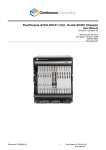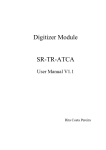Download (M-LVDS) Transceiver Evaluation Kit User Manual
Transcript
DS91D176 Multipoint-LVDS (M-LVDS) Transceiver Evaluation Kit User Manual April 2006 Rev 0.2 DS91D176 Evaluation Board User Manual Overview The purpose of this document is to familiarize you with the DS91D176 evaluation board, suggest the test setup procedures and instrumentation, and to guide you through some typical measurements that will demonstrate the performance of the device. The primary function of the board is to assist a system designer in development and analysis of an M-LVDS clock distribution network in an ATCA backplane. The board also enables the user to examine performance and all functions of the DS91D176 as a standalone device. As a side feature, one can utilize the board to access switch fabric interface of an ATCA backplane. The DS91D176 is a high-speed M-LVDS differential transceiver designed for multipoint applications with multiple drivers or receivers. The device conforms to TIA/EIA-899 standard. It utilizes M-LVDS technology for low power, high-speed and superior noise immunity. Description Figure 1 below represents the top layer drawing of the board with the silkscreen annotations. It is a 6 x 4 inch 10 layer printed circuit board (PCB) that features seven DS91D176 (U1-U7) devices. Figure 1: DS91D176 Evaluation Board - Top View Devices U1 through U6 can serve as building blocks for M-LVDS clock distribution networks in ATCA backplanes. Their M-LVDS I/O pins directly connect to the first two row pins of J4, which is an ADF (Advanced Differential Fabric) connector. When J4 is inserted into any ATCA backplane slot (location J20/P20 for those of you familiar with ATCA backplanes), the M-LVDS I/O pins of each device electrically connect to one of the clock busses (there are six clock busses in an ATCA backplane – See Figure 3). The PCB traces that connect device M-LVDS pins with the J4 connector pins have different characteristics for each device. These traces are also 2 DS91D176 Evaluation Board User Manual called stubs. Table 1 provides characteristic of each stub, M-LVDS pins to J4 pin mapping and LVCMOS pins to J2 pins mapping. Device U1 U2 U3 U4 U5 U6 M-LVDS Pins A1 B1 A2 B2 A3 B3 A4 B4 A5 B5 A6 B6 J4 Pins B1 A1 D1 C1 F1 E1 H1 G1 D2 C2 B2 A2 Stub Length 0.25” ZSTUB 100 Ω 0.50” 100 Ω 1.00” 130 Ω 1.00” 100 Ω 1.00” 80 Ω 2.00” 100 Ω LVCMOS Pins R1 D1 R1 D1 R1 D1 R1 D1 R1 D1 R1 D1 J2 Pins 2 4 6 8 10 12 14 16 18 20 22 24 Table 1: U1-U6 Stub Characteristics and Pin Mapping J1 configures U1 through U6 as either driver or receiver. J7 and J8 are power and ground banana plug receptacles. J5 and J6 are redundant power and ground connections. U7 is for a standalone evaluation. Its I/O pins (both, M-LVDS and LVCMOS) connect to SMA connectors (SMA5-SMA8) for easy interface with instrumentation. J3 configures U7 as either driver or receiver. There is a provision to terminate M-LVDS inputs of the U7 with a SM0603 sized resistor. Connectors, SMA1, SMA2, SMA3 and SMA4 connect to J4 pins H2, G2, F2 and E2 respectively. If the board is plugged in an ATCA backplane, locations J21/P21, J22/P22, J23/P23 and J24/P24 in any slot, fabric interface is accessed with these connectors. Figure 2 provides a simplified block diagram view of the signal paths between the connecters and IC’s. 3 DS91D176 Evaluation Board User Manual Figure 2. Simplified Signal Path Block Diagram 4 DS91D176 Evaluation Board User Manual Building an Evaluation M-LVDS Clock Distribution Network in an ATCA Backplane The following is a recommended procedure for building an evaluation M-LVDS clock distribution network with DS91D176 evaluation boards. The assumption is that the user already has an ATCA backplane. Figure 3 depicts configuration of a generic M-LVDS clock network in an ATCA backplane. 1. Use two or more DS91D176 evaluation boards and install them at backplane location J20/P20, in the desired slots. 2. Apply the power to the boards (3.3 V typical) between J7 and J8 banana plug receptacles, observe the value of ICC, and compare it with the expected value (refer to the datasheet) to ensure that the devices are functional. 3. Select the board you want to configure as a clock driver/distributor. This is accomplished by setting DE and RE* pins to VDD (J1). Connect a clock generator to one of the driver inputs (J2). 4. Configure the remaining boards as clock receivers. This is accomplished by setting DE and RE* pins to GND (J1). 5. Observe clock waveforms by either connecting receiver LVCMOS output pins (J1) directly to an oscilloscope or by probing receiver M-LVDS input pins with a differential probe. Figure 3. M-LVDS Clock Distribution Network in an ATCA Backplane The above block diagram details the clock channels. They are all 130-ohm differential and doubly terminated with 80 ohms at either end of the backplane. The parallel combination of 80-ohm resistors means that the MLVDS devices will be driving a 40-ohm load termination. The maximum stub length from the backplane is defined in the ATCA standard as 1 inch or 2.5 cm. 5 DS91D176 Evaluation Board User Manual Figure 4 shows a picture of a 14-slot ATCA backplane fully populated with DS91D176 evaluation boards. Figure 4. DS91D176 Evaluation Boards in an ATCA Backplane Figure 5 shows 19.44 MHz clock waveforms obtained with a differential probe, Tektronix P6330, on the M-LVDS input pins of U1, U2, U4 and U6 devices of the receiver board in slot #8. The14-Slot backplane was fully populated. The clock driver/distributor board was in slot #7. Figure 5. 19.44 MHz Clock Waveforms Show Stub Length Effects on Signal Integrity 6 DS91D176 Evaluation Board User Manual Building an Evaluation Point-Point Link with DS91D176 Evaluation Boards The following is a recommended procedure for building an evaluation M-LVDS point-point network with DS91D176 evaluation boards. Figure 6 depicts a typical setup and instrumentation used for evaluation of a point-to-point link. 1. Use two DS91D176 evaluation boards 2. Apply the power to the boards (3.3 V typical) between J7 and J8 banana plug receptacles, observe the value of ICC, and compare it with the expected value (refer to the datasheet) to ensure that the devices are functional. 3. Configure U7 on one board as a driver. This is accomplished by setting DE and RE* pins to VDD (J3). Connect a signal generator to the driver inputs (SMA6). 4. Configure U7 on the other board as a receiver. This is accomplished by setting DE and RE* pins to GND (J3). 5. Select a differential interconnect with balanced 100-ohm differential impedance (i.e. UTP cable) and connect the M-LVDS pins of both devices with it. 6. Terminate the interconnect with a matching resistor on the inputs of U7 on the receiver board (R1). 7. Observe waveforms by either connecting the receiver LVCMOS output pins (SMA5) directly to an oscilloscope or by probing receiver M-LVDS input pins with a differential probe. Figure 6. M-LVDS Point to Point Link with DS91D176 Boards and UTP Cable 7 DS91D176 Evaluation Board User Manual Figure 7 shows eye diagrams acquired at the output of the DS91D176 driver loaded with a 100-ohm resistor and after 50 m Cat5e cable terminated with a 100-ohm resistor. The generator connected to the driver input simulated a 100 Mb/s PRBS-7 NRZ. Figure 7: Eye Diagram Before and After 50 m of Cat5e 8 DS91D176 Evaluation Board User Manual Microstrip and Stripline Geometries Used Figures 8 to 12 show trace geometries used in the board design. Table 2 provides trace type to electrical net cross-reference. Trace Type / Figure 50-ohm Single-ended Microstrip / Figure 8 100-ohm Differential Microstrip / Figure 9 100-ohm Differential Stripline / Figure 10 130-ohm Differential Stripline / Figure 11 80-ohm Differential Stripline / Figure 12 DS91D176 Evaluation Board Nets All LVCMOS nets U7 M-LVDS nets, SMA1-SMA4 nets U1, U2, U4, U6 M-LVDS nets U3 M-LVDS nets U5 M-LVDS nets Table 2: Trace Type to Electrical Net Cross-reference. Figure 8. 50-ohm Single-ended Microstrip 9 DS91D176 Evaluation Board User Manual Figure 9. 100-ohm Differential Microstrip Figure 10. 100-ohm Differential Stripline 10 DS91D176 Evaluation Board User Manual Figure 11. 130-ohm Differential Stripline Figure 12. 80-ohm Differential Stripline 11 DS91D176 Evaluation Board User Manual Layer Stack Up: 1/2 oz. ------------------- SIG1 10 mills 1/2 oz. --------------------GND 15 mills 1/2 oz. ------------------- SIG2 15 mills 1/2 oz. --------------------GND 3 mills 1/2 oz. --------------------PWR 3 mills 1/2 oz. ------------------- PWR 3 mills 1/2 oz. --------------------GND 15 mills 1/2 oz. ------------------- SIG3 15 mills 1/2 oz. ------------------- GND 10 mills 1/2 oz. ------------------- SIG4 Bill Of Materials Item Quantity Reference Part _____________________________________________________ 1 2 2 9 3 9 4 5 6 7 8 9 10 11 11 12 2 1 1 2 1 1 4 4 7 1 C18, C1 C2, C4, C5, C6, C7, C8, C9, C10, C19 C3, C11, C12, C13, C14, C15, C16, C17, C20 J3, J1 J2 J4 J5, J6 J7 J8 SMA1, SMA2, SMA3, SMA4, SMA5, SMA6, SMA7, SMA8 U1, U2, U3, U4, U5, U6, U7 R1 22u; SM7343; C1 Not Installed; 0.1u; SM0603; C2 Not Installed; 0.01u; SM0603; C3 Not Installed; Molex 90131-0123 Molex 90130-3124 Tyco HM-ZD 1469001-1 Pomona 3267; Not Installed; Johnson Components 108-0902-001 Johnson Components 108-0903-001 Not Installed; Johnson Components 142-0701-231 DS91D176TMA 50; SM0603; Not Installed; 12 DS91D176 Evaluation Board User Manual Schematic J3 VCC_3V DE1 GND U2 R2 RE1* DE1 D2 SMA1 4 5 GND GND SIG 1 TX+ GND GND SIG 1 TX- GND GND SMA3 2 3 4 5 GND GND SIG 1 RX+ 1 3 5 7 9 11 13 15 17 19 21 23 1 3 5 7 9 11 13 15 17 19 21 23 2 4 6 8 10 12 14 16 18 20 22 24 2 4 6 8 10 12 14 16 18 20 22 24 U3 R3 RE1* DE1 D3 4 5 A1 B1 BG1 C1 D1 DG1 E1 F1 FG1 G1 H1 HG1 B2 A2 GND 1 2 3 4 R VCC RE* B DE A D GND VCC_3V 8 7 6 5 U4 R4 RE1* DE1 D4 1 2 3 4 R5 RE1* DE1 D5 1 2 3 4 Molex 90130-3124 R VCC RE* B DE A D GND 8 7 6 5 U5 SIG TX+ TXGND RX+ RXGND VCC_3V B4 A4 GND DS91D176TMA GND GND GND GND B3 A3 GND DS91D176TMA SMA4 2 3 8 7 6 5 J2 GND 4 5 R VCC RE* B DE A D GND DS91D176TMA GND GND SMA2 2 3 1 2 3 4 1 RX- R VCC RE* B DE A D GND VCC_3V 8 7 6 5 A2 B2 BG2 C2 D2 DG2 E2 F2 FG2 G2 H2 HG2 B5 A5 GND U6 GND 1 2 3 4 R VCC RE* B DE A D GND SIG 1 U7 R7 RE2* DE2 D7 GND GND GND SMA7 4 5 1 2 3 4 R VCC RE* B DE A D GND VCC_3V 8 7 6 5 1 B7 A7 GND GND SIG GND GND R1 50 GND GND 1 SIG 1 Not Installed GND GND 5 4 J5 3 2 1 1 VCC_3V SMA8 DS91D176TMA SMA6 2 3 A6 B6 BG6 C6 D6 DG6 E6 F6 FG6 G6 H6 HG6 B6 A6 GND DS91D176TMA 4 5 A6 B6 GND C6 D6 GND E6 F6 GND G6 H6 GND A7 B7 BG7 C7 D7 DG7 E7 F7 FG7 G7 H7 HG7 VCC_3V 8 7 6 5 SMA5 GND GND Tyco HM-ZD 1469001-1 A2 B2 GND C2 D2 GND E2 F2 GND G2 H2 GND A7 B7 GND C7 D7 GND E7 F7 GND G7 H7 GND DS91D176TMA GND GND R6 RE1* DE1 D6 2 3 A1 B1 GND C1 D1 GND E1 F1 GND G1 H1 GND A3 B3 BG3 C3 D3 DG3 E3 F3 FG3 G3 H3 HG3 2 3 J4 VCC_3V A5 B5 GND C5 D5 GND E5 F5 GND G5 H5 GND DS91D176TMA A8 B8 GND C8 D8 GND E8 F8 GND G8 H8 GND B1 A1 GND A8 B8 BG8 C8 D8 DG8 E8 F8 FG8 G8 H8 HG8 VCC_3V 8 7 6 5 A5 B5 BG5 C5 D5 DG5 E5 F5 FG5 G5 H5 HG5 R VCC RE* B DE A D GND A9 B9 BG9 C9 D9 DG9 E9 F9 FG9 G9 H9 HG9 1 2 3 4 A9 B9 GND C9 D9 GND E9 F9 GND G9 H9 GND U1 R1 RE1* DE1 D1 Molex 90131-0123 A4 B4 GND C4 D4 GND E4 F4 GND G4 H4 GND 2 4 6 A4 B4 BG4 C4 D4 DG4 E4 F4 FG4 G4 H4 HG4 2 4 6 A10 B10 BG10 C10 D10 DG10 E10 F10 FG10 G10 H10 HG10 1 3 5 A10 B10 GND C10 D10 GND E10 F10 GND G10 H10 GND 1 3 5 A3 B3 GND C3 D3 GND E3 F3 GND G3 H3 GND VCC_3V RE1* GND Pomona 3267 GND GND SIG GND GND 5 4 C3 0.01u C2 0.1u + C1 22u J6 GND 3 2 1 GND 1 Pomona 3267 J7 1 VCC_3V 1 VCC_3V J1 VCC_3V RE2* GND 1 3 5 1 3 5 2 4 6 2 4 6 VCC_3V DE2 GND Molex 90131-0123 GND C10 0.1u C9 0.1u C8 0.1u C7 0.1u C6 0.1u C5 0.1u C4 0.1u Johnson Components 108-0902-001 C20 0.01u C19 0.1u + C18 22u J8 GND Place one 0.1uF and one 0.01uF cap close to VDD pin of each DS91D176 1 1 VCC_3V Johnson Components 108-0903-001 GND C17 0.01u C16 0.01u C15 0.01u C14 0.01u C13 0.01u C12 0.01u C11 0.01u Title ATCA Line Card Size B Date: 13 Document Number M-LVDS Wednesday, January 18, 2006 Rev 0.2 Sheet 1 of 1 DS91D176 Evaluation Board User Manual Revision History Revision 0.1: Initial draft – dglisic 12Apr2006 Revision 0.2: Minor edits, added simplified block diagram – bstearns 14 April2006 15
















